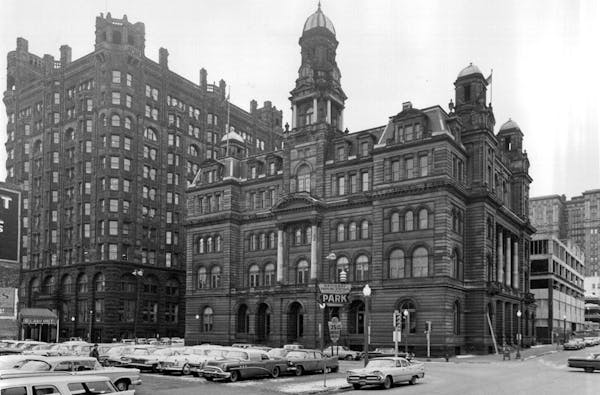Although it maintains a business-as-usual appearance, the Southdale Library in Edina is in the midst of a metamorphosis.
Hennepin County has spent the past several years examining a reboot of the 46-year-old building. An extensive study gathered significant community input and yielded three proposals.
All the proposals call for demolition of the current library, located at 70th Street and York Avenue S., and carving up the large site, reserving a portion for a new facility and funneling the rest into commercial, housing and parking uses.
Shortly before a decision was announced, a wrinkle emerged from an unusual source: the declining department store industry.
Specifically, the demise of Herberger's, which left a major vacancy at nearby Southdale shopping center. Suddenly, a fourth library feasibility study materialized.
"We felt like it was our responsibility to explore options," said Margo Geffen, director of facility services for Hennepin County. "The timing presented this unique opportunity."
The fourth proposal was outside the library norm: The former Herberger's, empty since late August, would be demolished, and a new 58,000-square-foot library (roughly the same size as the current facility) would rise in its place.
This is an excellent idea.
Hennepin County staffers agree. They've recommended to the county's Board of Commissioners that this is the option that should be pursued. Their reasoning? Connections.
"It's exciting for us to be in proximity to a place where we can engage the community, and be a part of community life," said Janet Mills, Hennepin County Library interim director. "From the library's perspective, I can't think of a downside. There are so many advantages. We'll have the opportunity to expose more people to the library experience."
A win-win scenario
Replacing a defunct department store with a busy public institution will clearly benefit both Southdale and the library.
In 2017, the library generated 329,550 visits. That's a sizable audience of potential shoppers, who could conveniently combine, say, a reading at the children's library with a back-to-school buying spree at Gap Kids.
In today's real estate parlance, it's a relationship known as co-location.
The process would be relatively bump-free, since the library would continue to operate at its current location until its replacement at the mall was move-in ready. By comparison, building on the existing site would shut out library patrons for at least 18 months.
Transit access would certainly improve, since Southdale's transit station is conveniently located near the former Herberger's. It's a hub for several times the number of bus routes that serve the current library.
And there are positive fiscal considerations, as well. The library's current site — a large, high-profile plot in a premium neighborhood — is a plum asset on the county's balance sheet. Its sale would boost public coffers and also presumably return the valuable property to tax-generating uses.
True, the library would become a renter, a change from its traditional ownership position; however, library officials estimate that in the long run, renting would be significantly less expensive than the estimated $50 million for new construction on the current site.
(If demolishing the current 46-year-old library seems premature, consider this: The predecessor to the current Cesar Pelli-designed Central Library in downtown Minneapolis came down in 2001 at the ripe old age of 41.)
Placing a library in a shopping mall could also deflate the kind of architectural gravity that's often associated with civic institutions. But given that the current Southdale Library resembles an overgrown carport, this isn't a weighty consideration.
Relocation to Southdale would require investment beyond a new structure. Overt pedestrian and bicycle connections would have to navigate the asphalt sea surrounding the shopping mall, solidly connecting the library to York Avenue. A good role model is the well-landscaped Edina Promenade, the nearby ¾-mile corridor that links Centennial Lakes Park with the Galleria.
York Avenue would also have to be reconfigured to emphasize human-scaled amenities while still serving its heavy traffic demands.
Built for change
With retail in flux, 63-year-old Southdale is an ideal laboratory, because evolution has long been a part of its DNA.
When the nation's first enclosed suburban shopping center opened in 1956, it was home to a supermarket (Red Owl) and a two-level five-and-dime with a lunch counter (Woolworth). Both are long gone. A second interior courtyard, anchored by the mall's third department store, J.C. Penney, came along in the early 1970s.
In 2002, the mall sprouted a 16-screen multiplex and several big-box chain restaurants. The movement beyond retail has recently escalated, with portions of Southdale's vast, underused parking lot being repurposed into apartments and a hotel.
The most visible sign of the mall's reincarnation is currently under construction: a high-end Life Time fitness center and co-working facility is going up where J.C. Penney once stood.
It also helps that Hennepin County is no stranger to Southdale. The county's service center, which once shared space with the library, has been a mall tenant since 2016.
The library proposal certainly falls in line with the intent of Southdale's architect, Victor Gruen.
In a 1954 Minneapolis Tribune article, Gruen stressed the planned community aspect of Southdale, seemingly with the library in mind.
"We need a better term than 'shopping center,' " he said. "A satellite downtown, like Southdale, besides performing its business function, will fill the vacuum created by the absence of social, cultural and civic crystallization points in our vast suburban areas. Humans want to mingle with other humans. We have re-created an old architectural form — the square or plaza."










